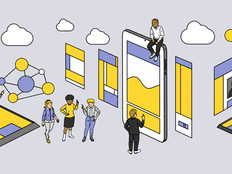What's In Your Toolbox?
Asset tracking, patch deployment and centralized updates are major reasons colleges are turning to client management software.
It certainly isn’t easy being the IT manager of a college or university. You face the formidable task of managing a growing number of computer devices that run a mix of operating systems, off-the-shelf software and custom applications. Fortunately, there’s a useful technology tool that can help IT professionals address this challenge: client management software (CMS).
CMS enables administrators to manage desktop and portable PCs centrally and automatically. The basic capabilities of these software suites include operating system deployment and migration; application deployment; patch management; and hardware and software asset and inventory management.
The market for CMS products aimed at managing PCs has grown steadily in the past few years, reaching about $3 billion in worldwide sales in 2005, according to David Friedlander, senior analyst at Forrester Research in Cambridge, Mass. “The need to reduce operating costs, keep track of assets and automate tasks such as patch deployments and application updates is driving demand for these products,” he says.
The technology is beneficial to educational institutions, especially those with a large inventory of desktop computers, a growing number of mobile users and complex environments.
Remote Control
Dartmouth College in Hanover, N.H., is using the LANDesk Management Suite and LANDesk Security Suite from LANDesk Software to help manage its IT environment. The college deployed the management suite in 2004 and uses it to remotely distribute operating system and application software to some 1,400 computers used by college employees, says Tim Chiacchira, enterprise administrator at Dartmouth.
“The biggest benefits are time and labor savings,” he says. “If we had to go to every machine to install a new application, or update or migrate the operating system, it would take an immense amount of time.” For example, it takes about two hours just to set up a single device with an operating system.
In the past, the college typically would have had to hire a consulting firm to do major installation projects — at a huge cost. “We’ve saved money in not having to do that,” he says.
“In many cases, we would not have done large-scale software distribution or patch deployments” because of the cost. As a result, there were frequent problems with getting software upgrades out to college administrators and other employees.
Using the security suite, Dartmouth has the ability to quickly and automatically distribute the latest security patches and antivirus software to thousands of computers used by students and faculty members. It uses the software to track and update about 1,000 desktop and notebook PC devices.
The college is licensed for up to 6,000 machines, Chiacchira says, and is installing the software on all new student and faculty devices to keep them up to date on security protection. “Within four years we expect to have every computer on campus on the system,” he adds.
In addition to helping the college more efficiently distribute security updates and manage antivirus products, the software detects and blocks the installation of spyware, and will help prevent malware attacks such as viruses, worms and trojans, Chiacchira says. Like many other colleges, Dartmouth has been plagued by security breaches, and officials hope the software will help prevent intrusions and other threats.
The client management software suites run on three servers, one for each suite and a third that runs a database. Among the challenges of implementing CMS is getting the support staff to understand the full capabilities of the technology, Chiacchira says. “You could have people use these products to do very basic things,” he says. “But if you really want to get your money out of the software, you need to train people to use the software most effectively.”
Inventory Management
At Miami University in Oxford, Ohio, client management software is helping managers keep track of the growing inventory of PCs and determine which devices need to be upgraded or replaced. The school purchased the Altiris Total Management Suite in late 2005 and is gradually rolling out the software to some 10,000 computers used by faculty and staff.
Before using the software, managers had to guess how many computers were in use on the campus, recalls Robert Howard, senior director of support services and campus partnerships. “We didn’t know what we had,” he says. “People had inventory lists, but a lot of times, the list for PCs had no granularity.
“The client management software gives us very detailed information on the hardware of the machines. We can see things such as whether a user needs to add memory for a new version of an operating system.”
By enabling more efficient PC support, client management software helps free up the IT staff to assist faculty in using technology rather than making sure it’s working, which benefits students, Howard points out. There also will be cost containment, because Miami University will not need to hire as many additional support people as the number of devices increases.
In the future, Miami University plans to use a server component of the suite to distribute security patches to devices. It will also offer the client software as an option for student-owned computers beginning in the fall.
Focus on Security
Central Washington University (CWU) in Ellensburg, Wash., began using client management software called ZENworks from Novell in 1999 when it switched to a new campuswide e-mail system.
“In order to ensure that only valid CWU staff and students could use the network and computer systems, all users were assigned Novell accounts and Groupwise e-mail accounts,” says Lynn Linnell, supervisor of client support services. “Shortly after that, we started using ZENworks to assist in the management of the desktop computers and for remote management both on campus and in our off-campus centers.”
CWU’s heightened focus on IT security and its increasing computer power, Linnell says, “made it obvious that we had to limit use of our systems to valid users.”
In addition, the university had a large user base at its main campus in Ellensburg and at its six University Centers throughout Washington state. One of CWU’s objectives was to have greater control of its IT assets.
“The software allows us to control many of the desktop computers on campus without having to visit each computer,” Linnell explains. This is especially helpful in computer labs, where the technicians need to work on only one of the computers, adds Jim Pruitt, IT specialist at the university.
Most labs have multiple classes in them, and it’s difficult to work on the computers without disrupting the class, Pruitt says. The software minimizes the impact — and makes life a little easier for the IT staff.
And when life is a little easier for the IT staff, everyone is happy.
Bob Violino is a freelance technology writer based in Massapequa Park, N.Y.
The Value of CMS
For IT staff, the benefits of client management software include:
Labor Savings
Thousands of desktop and notebook PCs can be remotely managed from a central location.
Network Protection
Security patches and antivirus applications are distributed instantly. Also, spyware and malware can be detected and removed.
Inventory Control
Computer inventory is efficiently tracked and managed. Older PCs can be easily identified and upgraded or replaced.






